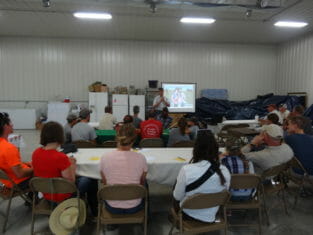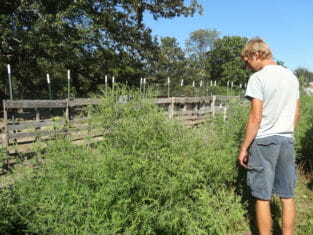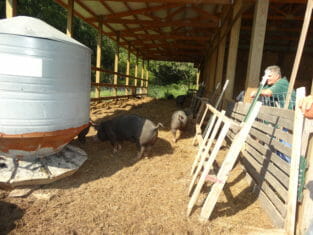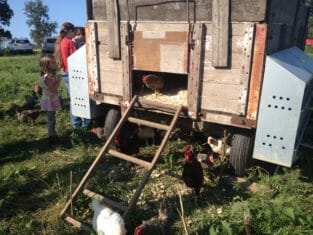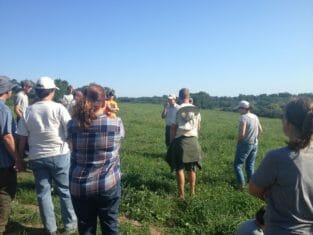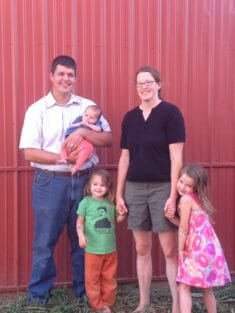Field Day Recap: Lipes Family Farm – Getting Started With Pasture Based Livestock, August 21
37 people gathered on a beautiful Friday afternoon at the Lipes Family Farm to hear how Greg and Katie Lipes got started with pastured-based farming. The Lipes’ had an interesting start to their business. Neither Greg nor Katie were born into farming – a situation that often makes it hard to break into the field. (Pun intended) It was during grad school and after a Farm Beginnings course the couple made the goal of becoming full time farmers. They started with 5 acres, off-farm jobs, reading everything they could about grass-fed beef, and learning on the go. It’s now 5 years and 3 beautiful little girls later. Greg and Katie are both on the farm full time. Their West Branch farm is 178 acres (1/2 pasture, ½ timber) and provides a space for their pasture-based beef, pork and poultry enterprises.
So how did they get there?
Tables were full in the Lipes machine shed as Greg shared how he and Katie became full time farmers. About the time Greg and Katie were looking for a place to farm, Greg’s parents were looking for a place to retire. Greg encouraged his parents to consider the costs associated with buying a lot in town compared to purchasing farmland. They decided to purchase the farmland with plans to build a house at the farm when they retire. Greg currently rents the land and buildings from his parents. There is no house on the site. Greg, Katie and their 3 daughters live in a 600 square foot area walled off in one of the buildings. “The space is tiny, but it’s all we really need,” he said.
Farming full-time came with some adjustments for the Lipes, but they did it. Greg gave an insightful presentation of how he and Katie made it work.
- Prepared for no regular income
- Prepared for no real income for 2 years – waiting for the beef to finish on grass
- Lived off savings during that time
- Lived frugally in preparation for not having a nest egg
The Lipes stick to a self-sustaining farm philosophy including:
- Do not rely on debt for depreciating assets
- Any land, tractors, buildings, etc must be bought with cash on hand
- They work for themselves, not the bank
- They currently don’t have debt, but if they did, it would only be for appreciating assets used to grow the business
But what about needing STUFF and not having MONEY?
Pallets. Pallets. And more pallets! Katie is a whiz at designing small farm structures/equipment they need from pallets. Greg also gave this advice to those looking to start with little money:
- Use Craig’s list or Freecycle
- Use scrap lumber/tin
- Ask businesses about used pallets
- Lots of things others don’t want, you can find a use for
- Use your own cheap labor – you can find out how to do most anything on YouTube!
Marketing
Many attendees at the field day had questions about how Greg markets his pasture-based meat. When asked if he had plans to transition to organic, Greg replied: “I don’t foresee us going organic. I talk to my customers and get the relationship going so they know how I’m raising my product. That’s most important.”
The Lipes sell about 70% of their meat by the cut, with 30% sold in bulk (by wholes and halves.) Greg figures he makes more profit per animal selling by the cut, but it’s a lot more work. He suggested if you can sell in bulk – that is the way to go. Using farmers markets, on-farm sales and buying clubs are the primary ways the Lipes move their products. To sell more unpopular cuts, Greg either has them made into sausage or hamburger, or promotes them through lowering the price. They currently have not found a profitable way to work with coops, grocery stores or restaurants because those markets only want certain cuts.
To figure pricing for his products, Greg is careful to include the costs associated with the enterprise even when it’s not productive. For example, his egg break even price is $4/dozen. One attendee commented that seemed like a lot. However, Greg explained he figures his expenses, including using non-GMO feed, over the course of an entire year – including winter when egg production declines. The Lipes are also careful keep records of the meat and eggs their family buys from their farm.
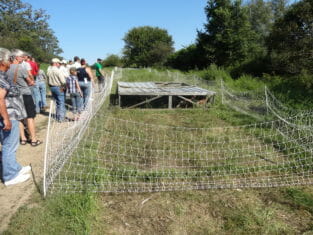
Turkeys are raised inside Joel Salatin style chicken tractors. The electro-netting fence around the outside is used to keep predators out. Greg has not had to electrify it for some time as predators are respecting the barrier.
The field day continued with a walk through the farm. Greg shared production methods for his pasture-based poultry, pork and beef enterprises. After the farm tour attendees enjoyed a potluck. The main dish – delicious meat right from Greg and Katie’s farm!

